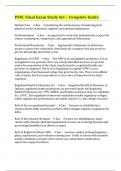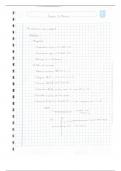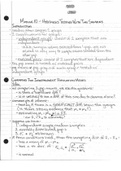Basic Textiles V
Finishing: Pre-Treatment
Textile dyeing and finishing is composed of a group of processes used to convert greige textile
materials into finished textile products. Preparation, dyeing or printing and finishing.
Preparation: the process of preparing fiber, yarn of fabric for subsequent end uses. To remove
impurities that will interfere with processing through dyeing and finishing functions.
Goal of preparation:
- Producing textile that has rapid and uniform absorption of water. Important for dyeing, finishing, etc.
- Uniform standards of white. There are no white dyes for textiles.
- Uniformly swollen fibers for transport of dyes and chemicals (absorption).
- Minimal fiber damage.
- Constant pH.
- Uniform residual moisture content.
Problems in preparation:
- Quality of raw material.
- Poor preparation leads to poor performance and quality results in the finished textile product.
Preparation processes
- Singeing produce smooth fabric surface, minimum pilling natural/synthetic/blends
- Desizing removes warp sizing woven fabrics
- Scouring removes impurities in textile all fibers, yarns, fabrics
- Bleaching destroys color impurities
- Optical brighteners whitening agents for white products (“colorless dyes”)
- Enzyme processes removes wild fiber hair from fabric urface with cellulase enzymes cellulose
- Mercerization improve cotton propertie with odium hydroxide cotton
- Heatsetting rearrange internal molecular structure thermoplastic synthetics
- Spandex produces highly stretchable fibers
Singeing natural or synthetic
Purpose is to clean fabric surface and reduce pilling. The singer
uses propane/natural gas flames to burn off the fuzzy surface fiber.
Problem: uneven intensity of gas flames, often noticed after dyeing
(shade difference).
Thermoplastic synthetic fibers should not be singed before dyeing
light/pastel shades. Melt balls will form, melted fiber tips dye more
intense than normal fiber. So: singeing after dyeing.
Any heat sensitive fiber should be singed with care. Some materials
have high elongation because of high temperature..
The lighter the fabric, the faster the speed of the machine. Fabric
must be cooled right after (using cooling cans with cold water).
1
, Basic Textiles V
SINGE AND DESIZE RANGE
Cloth flows directly from
one process to the other.
Range Efficient
(minimum water,
chemicals, electricity,
time needed)
Highest fixed costs
(quantities must be high
enough)
Ranges can be open
width or in rope form. This is open width.
Brusher after singeing to raise loose fibers for uniform singeing. Optional.
Saturator for desizing process applying chemicalls to fabric.
J-box serves steam to keep temperature of fabric (200 F)
After washing, fabric is dries over hot stainless steel cans filled with steam.
Desizing woven fabrics
Process used to remove the size added to the warp yarns during weaving.
Size: compound added to warp yarns to give strength during weaving.
CHEMICALS Necessary to know chemical nature of size in order to desize. Startch-based enzymes.
PVA/CMC no enzymes.
FACTORS AFFECTING ENZYME ACTION
- Time
- Temperature
- pH
- Surfactants
After desizing, spot checks can indicate any residual sizing material left on fabric. Iodine turns blue
when in contact with starch
Scouring all fibers
Removes dirt, grease, wax and oil impurities.
Scouring is done in water baths using surfactants/detergents/soaps. Soaps are sensitive to hard water.
Detergents less sensitive, preferred. Hard water: calcium, magnesium in water.
Solvent scouring does not remove water-based dirt, sand and grit very well. Majority of finishes use
aqueous scouring systems.
To determine effectiveness: test in lab using extraction and impurity residue measurement procedures.
Synthetic fibers (olefins and polyester) have attraction to oil-based impurities. Oil-removing detergents
prevent oily materials from re-depositing onto fabric.
2
Finishing: Pre-Treatment
Textile dyeing and finishing is composed of a group of processes used to convert greige textile
materials into finished textile products. Preparation, dyeing or printing and finishing.
Preparation: the process of preparing fiber, yarn of fabric for subsequent end uses. To remove
impurities that will interfere with processing through dyeing and finishing functions.
Goal of preparation:
- Producing textile that has rapid and uniform absorption of water. Important for dyeing, finishing, etc.
- Uniform standards of white. There are no white dyes for textiles.
- Uniformly swollen fibers for transport of dyes and chemicals (absorption).
- Minimal fiber damage.
- Constant pH.
- Uniform residual moisture content.
Problems in preparation:
- Quality of raw material.
- Poor preparation leads to poor performance and quality results in the finished textile product.
Preparation processes
- Singeing produce smooth fabric surface, minimum pilling natural/synthetic/blends
- Desizing removes warp sizing woven fabrics
- Scouring removes impurities in textile all fibers, yarns, fabrics
- Bleaching destroys color impurities
- Optical brighteners whitening agents for white products (“colorless dyes”)
- Enzyme processes removes wild fiber hair from fabric urface with cellulase enzymes cellulose
- Mercerization improve cotton propertie with odium hydroxide cotton
- Heatsetting rearrange internal molecular structure thermoplastic synthetics
- Spandex produces highly stretchable fibers
Singeing natural or synthetic
Purpose is to clean fabric surface and reduce pilling. The singer
uses propane/natural gas flames to burn off the fuzzy surface fiber.
Problem: uneven intensity of gas flames, often noticed after dyeing
(shade difference).
Thermoplastic synthetic fibers should not be singed before dyeing
light/pastel shades. Melt balls will form, melted fiber tips dye more
intense than normal fiber. So: singeing after dyeing.
Any heat sensitive fiber should be singed with care. Some materials
have high elongation because of high temperature..
The lighter the fabric, the faster the speed of the machine. Fabric
must be cooled right after (using cooling cans with cold water).
1
, Basic Textiles V
SINGE AND DESIZE RANGE
Cloth flows directly from
one process to the other.
Range Efficient
(minimum water,
chemicals, electricity,
time needed)
Highest fixed costs
(quantities must be high
enough)
Ranges can be open
width or in rope form. This is open width.
Brusher after singeing to raise loose fibers for uniform singeing. Optional.
Saturator for desizing process applying chemicalls to fabric.
J-box serves steam to keep temperature of fabric (200 F)
After washing, fabric is dries over hot stainless steel cans filled with steam.
Desizing woven fabrics
Process used to remove the size added to the warp yarns during weaving.
Size: compound added to warp yarns to give strength during weaving.
CHEMICALS Necessary to know chemical nature of size in order to desize. Startch-based enzymes.
PVA/CMC no enzymes.
FACTORS AFFECTING ENZYME ACTION
- Time
- Temperature
- pH
- Surfactants
After desizing, spot checks can indicate any residual sizing material left on fabric. Iodine turns blue
when in contact with starch
Scouring all fibers
Removes dirt, grease, wax and oil impurities.
Scouring is done in water baths using surfactants/detergents/soaps. Soaps are sensitive to hard water.
Detergents less sensitive, preferred. Hard water: calcium, magnesium in water.
Solvent scouring does not remove water-based dirt, sand and grit very well. Majority of finishes use
aqueous scouring systems.
To determine effectiveness: test in lab using extraction and impurity residue measurement procedures.
Synthetic fibers (olefins and polyester) have attraction to oil-based impurities. Oil-removing detergents
prevent oily materials from re-depositing onto fabric.
2




